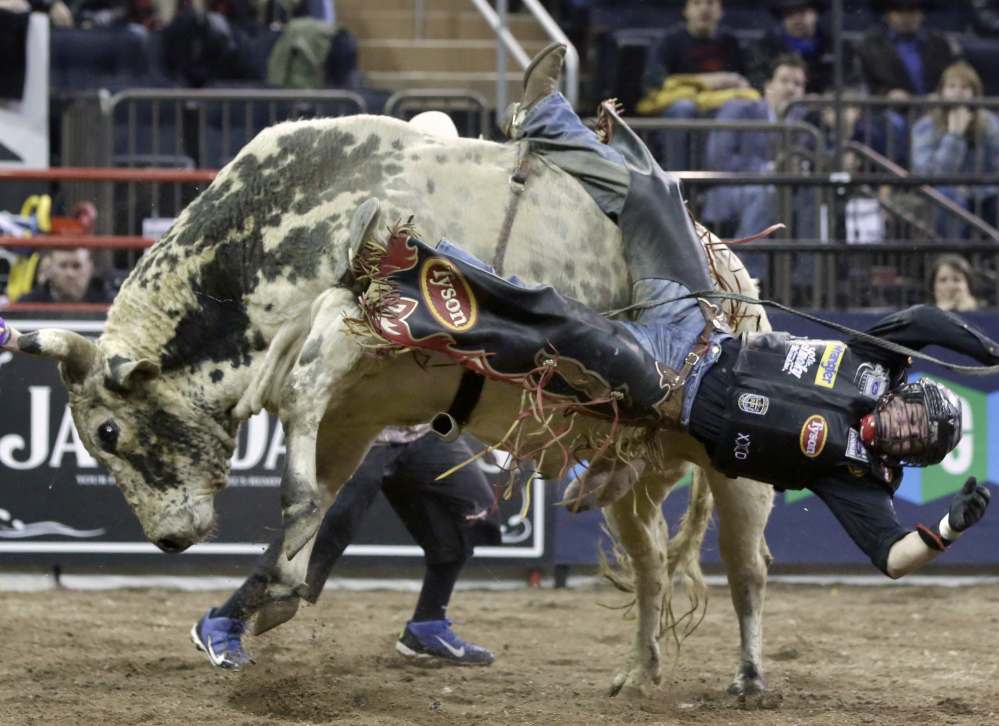SIOUX FALLS, S.D. — Kasey Hayes hopped on the bovine beast trapped in the narrow holding pen like he’d done hundreds of times. He adjusted a tight rope on his left hand, found his balance and signaled he was ready to dominate the bull for the next eight seconds – or, at least, hoped to.
The red metal gate swung open. The bull’s spine rolled, the animal charged forward and stood on its rear legs. The crowd cheered as the first ride on this March evening appeared promising. After 3.72 seconds, Hayes lost control, hit the ground and got his head stomped on by the 1,600-pounder named Shaft. His hockey-like helmet split in two. The arena fell silent.
“Come on Kasey. Come on son. Wake up,” a woman in the stands said as Hayes lay surrounded by doctors and athletic trainers. It took about a minute or so before Hayes could be helped to his feet. He had a concussion – the third in a 12-month period.
Serious injuries are occupational hazards for bull riders, but doctors, riders and researchers say the most pervasive injuries are concussions. The Professional Bull Riders’ circuit provides a stable of doctors, requires helmets for anyone born after 1994 and insists concussed riders pass a test before getting back in the saddle.
But in this era of concern about head injuries in the NFL and NHL, the circuit’s lead medical staffer says he hasn’t seen a drop in the number of concussions despite the widespread use of helmets. There are no multimillion-dollar contracts or unions in professional bull riding; if you don’t ride, you don’t eat, leading to athletes to push themselves back into action.
Few researchers have looked into the number of rodeo injuries, and very little data is available to detail the rate of concussions. The largest available set, collected from 1981 through 2005 at nearly 2,000 Professional Rodeo Cowboy Association-sanctioned events, shows 859 concussions were registered during various competitions such as calf roping, bareback riding and bull riding.
That amounted to 52.1 percent of all major injuries, and “anecdotally, the vast majority of them were bull riders,” according to Don Andrews, a retired athletic trainer who established the first sports medicine program in rodeo and assembled the data.
Concussions are the result of the brain banging against the skull. Side effects range from loss of balance, constant headaches, confusion, dizziness and vomiting. Recovery can take weeks or months.
More than a decade ago, a group of health care experts – including the PBR’s longtime medical team leader, Dr. Tandy Freeman – developed a set of guidelines to prevent and manage concussions and encourage the use of protective head gear.
Currently, all circuit riders must wear a protective vest, but only those born on or after Oct. 15, 1994, are obligated to use a helmet. Freeman said that the PBR, much like the NHL in the 1970s, decided to grandfather in helmet usage, though most riders wear them now. But helmets don’t prevent concussions, Freeman said.
Some riders lie about their symptoms to try to fool doctors into letting them ride again.
Copy the Story LinkSend questions/comments to the editors.



Success. Please wait for the page to reload. If the page does not reload within 5 seconds, please refresh the page.
Enter your email and password to access comments.
Hi, to comment on stories you must . This profile is in addition to your subscription and website login.
Already have a commenting profile? .
Invalid username/password.
Please check your email to confirm and complete your registration.
Only subscribers are eligible to post comments. Please subscribe or login first for digital access. Here’s why.
Use the form below to reset your password. When you've submitted your account email, we will send an email with a reset code.